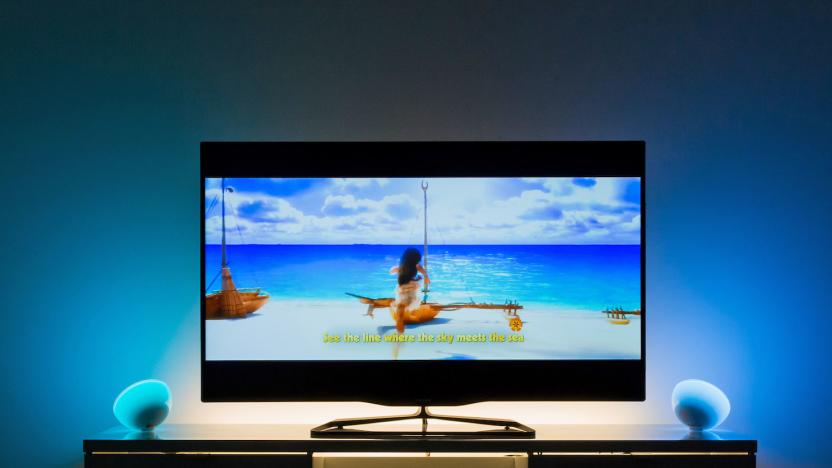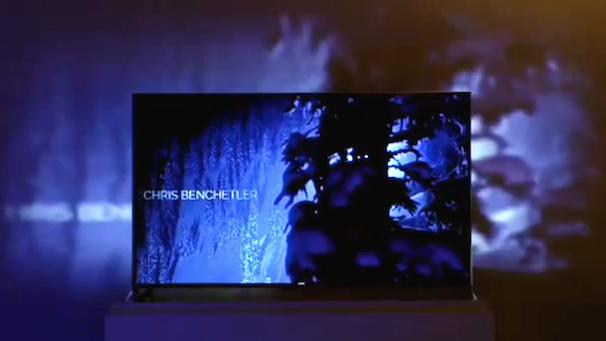ambilight
Latest

Philips' Hue lights will soon sync with movies, games and music
In the five years since Philips introduced its Hue range, it's been joined by many other companies offering their own version of its smart lighting. To stay ahead of the competition, the electronics giant has focused on adding platform partners, while introducing new bulbs that appeal to every kind of homeowner. To celebrate its fifth birthday, Philips confirmed today that it will further extend the compatibility of its kit and allow owners to synchronize their lights with movies, video games and music.
Matt Brian08.31.2017
Philips Afterglow promises a whole new generation of Ambilight TVs
Philips has been hawking Ambilight HDTVs with a series of customizable LEDs that let the picture "bleed" onto the wall behind for a decade now. At the company's annual IFA press conference, however, the company closed the show with a concept video called Afterglow, which, if it becomes a reality, might make TV viewing significantly more immersive. In a demonstration, action shots were recreated in detail beyond the bezel, as if some short-throw mini projectors have been welded to the underside of the TV. After asking around, it transpires that the tech isn't a concept as much as a very early prototype, and the technology won't be arriving until 2016 at the earliest. In terms of how the company has made the images, it won't say beyond that it's a "new" process, but since it hasn't been patented, no one's prepared to talk details. Still, given that Microsoft's Illumiroom isn't likely to become available to the mainstream, perhaps Philips' slightly more modest version might be the way forward.
Daniel Cooper09.04.2014
Philips' 2014 4K TVs include an Android-powered model and smaller sets
Philips' 4K TVs last year were on the large side, but it's following up in 2014 with smaller models -- including one with a few tricks up its sleeve. The company's new 55-inch 8809 series set mates the extra-high resolution with Android, giving you both Google Play apps as well as access to your Dropbox content. It's also a capable set whether or not you like the mobile OS, with a 1GHz refresh rate and Ambilight illumination that plays nicely with both games and Hue lights. There are also 48- and 55-inch 1080p sets running Android (the 8109 and 8209 series), and you can pick up the 7809 series (pictured here) in 42-, 49- and 55-inch flavors if you're comfortable using a 4K set without Google underpinnings. All of the new 7000 and 8000 series TVs should be available in Europe and Russia in the second quarter of the year, although the Android variants aren't expected to reach the UK. Pricing isn't available at this stage, but we'd expect these screens to be more affordable than Philips' 65- and 84-inch behemoths.
Jon Fingas03.27.2014
Philips intros Ambilight+Hue integration, 60-inch Elevation TV (video)
Philips makes colorful Hue light bulbs, and it (indirectly) makes colorful Ambilight TVs. Wouldn't it make sense if the two devices talked to each other? They do now: a new Ambilight+Hue app for Android and iOS coordinates Hue bulbs with compatible TVs, spreading Ambilight effects across the entire room. To mark the occasion, Philips and TPVision are launching the 60-inch Elevation TV (not pictured here). The 3D-capable, 1080p LCD introduces a four-sided Ambilight system that produces a fuller lighting effect when the set is wall-mounted. It's also the thinnest Philips TV to date, at 0.54 inches thick, and it includes the requisite smart TV features like Netflix, web browsing and Miracast media sharing. Ambilight+Hue should be available now, although Europeans will have to wait until later in the summer to buy the Elevation for about £2,800 ($4,168).
Jon Fingas07.10.2013
Insert Coin: Lightpack turns your computer display into an ambient backlight (video)
While Philips did eventually bring its Ambilight technology to PC monitors, it wasn't before others had decided to roll their own. Now you can add ambient backlighting to any computer display without any of the attendant soldering and Arduino-wrangling, thanks to the folks at Woodenshark. The team has built Lightpack, an Ambilight-esque system that'll connect to a Windows, OS X or Linux PC and project the display's colors onto the area surrounding the screen. Plug the hockey puck-sized device into your computer, attach 10 LED modules to the back of your display and install the open-source software and you're good to go. Once ready, you can even set up custom alerts to measure CPU temperature or email volumes, and even control the lighting with your smartphone or tablet. The team has asked for the unusually specific figure of $261,962 in order to fund an initial production run of 5,000 units, with early backers able to snag one of the units for $50 instead of around $90. Interested to watch it in action? There's a video after the break, friends.
Daniel Cooper04.25.2013
Oculight LED hack gives the Oculus Rift a hint of peripheral vision (video)
Although the Oculus Rift is one of the more ambitious attempts at making virtual reality accessible, its lack of peripheral version is all too familiar -- it's much like staring into a pair of portholes. Rather than let the disorientation persist unaltered, though, Hack A Day has taken matters into its own hands. Its Oculight hack puts an RGB LED strip inside the headpiece, with the colored lighting set to match the edge of the screen through Adalight code. The result is much like Philips' Ambilight, but arguably more useful: the virtual world's light "leaks" into the wearer's real peripheral view, adding to the immersion. Oculight clearly isn't for sale and needs a refined installation to create the ideal effect, but the readily available resources will let anyone with an Oculus Rift development kit build their own solution.
Jon Fingas04.11.2013
Arduino-powered lighting system infuses your LED with some Ambilight-like pizazz (video)
Why spend your hard-earned money on one of Philips' Ambilight displays when you can just make your own, using some Arduino-based wizardry and a little bit of elbow grease? Fortunately, Minty Boost creator ladyada is here to help. All you'll need is a strand of digital RGB LED pixels, a five-volt DC power supply (along with a female power adapter), any USB-equipped Arduino micro-controller and, of course, the appropriate Processing programming environment. You can find the full how-to at the source link below, but the results are pretty impressive -- a capture-based sketch system that's compatible with just about any media player. See it for yourself in the video after the break. [Thanks, Phil]
Amar Toor10.05.2011
Philips' Cinema 21:9 Platinum HDTV finally takes the leap into 3D
It's kind of hard to outdo yourself with only two dimensions when they read 21 and 9, respectively, so Philips has decided to do the only thing left for a trendy display maker: go 3D. Though we saw (and loved) a 3D prototype of the 56-inch variant at last year's IFA, this new, 58-inch Cinema 21:9 Platinum HDTV looks set to bring the third dimension to actual retail. It's got the Ambilight wall illumination that some people will like, LED backlighting with local dimming that most should love, and a slimmer, brushed matte bezel that will be appreciated by all. The 400Hz panel is capable of pumping out Full HD 3D and is expected to cost around €4,000 ($5,112) in Europe or £3,500 in the UK with a launch set for later this month. And if you want one in the US, well... things aren't looking very Ambibright for you. %Gallery-101115%
Vlad Savov09.02.2010
Philips intros new Ambilight HDTVs, speakers and other AV wares
Philips ain't much for introducing new gear here on US soil, but for those fortunate enough to buy their milk with Euros, the company has a cornucopiaof new kit to tempt you with. It seems as if the company chose to skip right over CES and do its own thing here in late February, with the "2010 Consumer Lifestyle" event bringing to us a refreshed lineup of LED-backlit Ambilight HDTVs (7000, 8000 and 9000 series), a new Immersive Sound home theater system (with tri-speaker satellites) and the aluminum-tinged Soundbar HTS9140. We're also told that the new line of 8000 and 9000 LED 1080p TVs are 3D capable, with a "3D upgrade pack" to be made available separately and include two Active3D glasses and a wireless transmitter. In related news, that now-forgotten Cinema 21:9 set -- which was supposed to ship many moon ago -- now has a "summer 2010" estimated arrival date on it, though we certainly aren't holding our breath just yet. Hit the source link for all the other goods, but don't expect to find much in the way of pricing and availability.
Darren Murph02.25.2010
Philips Aurea reaches 3rd generation, demands more allowance
Aww, just look at him, Philips' Aurea TV's all growed up and showing off the latest in LED edge-lighting. This third generation set features the same transparent Active Frame now sporting 250 LEDs with a promise of "exact" Ambilight color matching" with what you see on the screen. The result, according to Philips and our own experience with Ambilight over the years, is a more immersive viewing experience -- or maybe the experience is just peculiar, we can never be too sure. The set still features the same, albeit tweaked, motion sensitive remote control and adds Net TV for quick access to content from YouTube, eBay, TomTom and more depending upon your location. As to the display, well, it's still 42-inches by the looks of things, with a Full HD (1920x1080) resolution, 100Hz refresh, and snappy 2-ms response as before. The box itself feature an integrated DVB-T/DVB-C/CI+ HDTV receiver, 5x HDMI 1.3a EasyLink inputs, WiFi, Ethernet, and a DLNA-compliant network link for accessing media off your PC. Coming soon, that's when.
Thomas Ricker09.03.2009
Philips "Carousel" short shows what you're missing without Cinema 21:9 and Ambilight
We'll definitely be missing Philips UltraWidescreen 21:9 display with no U.S. release in the plans, but buyers world wide who need a bit of a convincer to drop the €4,000 need only check out the new Cinema "interactive movie." The 2+ minute feature takes you through a fictional movie setup with director, FX supervisor and director of photography chiming in on the importance of cinema widescreen. The interactive bit comes into play as the viewer can switch between 16:9 and turn Ambilight on and off on a simulated screen playing the flick. Cinema 21:9 launches this month in France, Germany, The Netherlands, Belgium, Luxembourg, Sweden, Denmark, Norway, Finland, and Russia, the trailer is embedded after the break (live demo video is here), check it out and let us know if you're ready to come out of pocket for this 2560x1080p beast.%Gallery-45472%
Richard Lawler04.16.2009
Philips' 56-inch Cinema 21:9 HDTV: not for Americans
Oh, bollocks! If one particular spokesman who opened up to ZDnet today is accurate, Philips' totally sweet 56-inch Cinema 21:9 HDTV won't ever be sold on American soil. Quite frankly, we're wondering what's up with Philips and its apparent disdain for the US market. It farmed out its Blu-ray / DVD and TV operations in North America to Funai, it didn't even bother showing up in Vegas for CES, and anything even remotely swank that it produces seems to be reserved for those overseas. What happened to the worldwide love, Philips? Did someone give you the impression that Yanks wouldn't buy one of these completely mesmerizing new panels? Sigh.[Thanks, Sean]
Darren Murph01.31.2009
Philips' 56-inch Cinema 21:9 HDTV gets showcased on video
Philips' groundbreaking Cinema 21:9 HDTV looked so curious when it launched a fortnight ago that we actually questioned its authenticity. Clearly, this beauty is for real. Pocket-lint was lucky enough to be on-hand for its unveiling in London, and it hosted up a nice video showing off the 56-inch beast in action. The black bars you've grown used to detesting were indeed gone, and while Philips wouldn't dole out any hard specifications, we are told that it boasts five HDMI sockets, a Spring release date and an estimated £3,000 ($4,276) price tag. Vid's after the break, per usual.
Darren Murph01.29.2009
Philips introduces ultra widescreen Cinema 21:9 LCD TV
Last July, we took a look at whether or not ultra widescreen HDTVs could eventually become a reality. Fast forward half a year and change, and here we have Philips answering that with a resounding "sure, why not?" The Cinema 21:9 is said to be the planet's first cinema-proportioned LCD TV, and of course, it'll also incorporate Ambilight technology around the borders. We'll be frank -- we had our doubts upon seeing the lackluster website linked below that this thing was even real, but Philips itself confirmed to us that the panel will be shipping this Spring in Germany, Belgium, the UK and France. We're also told that a full site will launch on January 29th, though no pricing details (nor a US release date) were mentioned. Our one and only wish? That this thing would've been displayed at CES last week.[Via GadgetVenue]
Darren Murph01.15.2009
Philips 42PFL9903D Aurea II HDTV reviewed, dubbed pretty amazing
There's no denying that the £2,500 42PFL9903D Aurea II is pricey, but for those with the requisite coin, you're probably wondering if this here set is a sound investment. The critics over at TrustedReviews were able to get one of these freshly released stunners into their labs for testing, and to simplify things, we'll just say they were thoroughly impressed. Not only was the tweaked design swooned over, but the Aurea Light Frame effects were also adored and the overall image performance was equally impressive. Granted, the sheer quantity of your disposable income will determine whether or not the whiz-bang LED effects are worth the premium, but at least to these reviewers, it was.
Darren Murph11.07.2008
Philips intros 42PFL9903D Aurea II LCD HDTV
Late in August, we got wind of an elusive Aurea II HDTV that was in development from Philips. Now, we're looking at the official result of that labor. The 42-inch Philips Aurea II (or 42PFL9903D, if you'd prefer) packs a 1080p panel, the latest version of the Perfect Pixel HD engine, a dynamic contrast ratio of 30,000:1 and a wicked fast two-millisecond response time. Reportedly, the main differences between this set and the original Aurea is a thinner frame, more curvaceous corners and an ever-so-slightly updated design. For those with the cash to blow, it'll be available for a stiff £2,499 ($3,967) this month.
Darren Murph11.06.2008
Philips launches 9600 Ambilight LCD TVs in UK
Just because Philips has hit some rough water with its TV products and even handed over the US production to Funai, that doesn't mean it's given up. Getting rolled out in the UK is the Ambilight 9600-series LCD TVs. While we're not fans of the Ambilight, the other improvements to the panels sound good to us. An updated Pixel Perfect HD system promises better black levels and contrast, and 100Hz (double the UK 50Hz mains frequency) Clear LCD wizardry should help minimize motion blur; at least as much as 120Hz does here in the US. If you need even deeper blacks, the new backlight can be dialed right down to 5-percent. If sunglasses are your thing, the torch mode on the backlight has been increased by 10-percent. Sounds good, but we'd like to see Philips bring its higher end models like these to the states for our peepers. The models we've seen over here don't exactly stop us in our tracks. Available in 32, 37, 42 and 47-inch sizes for £999, £1499, £1799 and £1999, respectively.
Steven Kim06.04.2008
Philips handing over North American TV manufacturing to Funai
We've had a feeling Philips wasn't really in love with the TV market lately, and now word comes from the New York Times that it will no longer manufacture displays for North America. The name -- and apparently the high concept Ambilight designs -- will still be on shelves, courtesy of a five year deal branding Funai-built televisions (already the name behind Emerson, Sylania, Symphonic and others.) Seeking -- like every other manufacturer lately -- to reduce risk and focus on its patents Philips will still design and manufacture TVs outside N.A., as well as oversee U.S. marketing, while Funai takes over all other operations Stateside beginning September 1.Update: Philips let us know Ambilight remains dead and buried, but its 2008 models will continue as planned.
Richard Lawler04.08.2008
Philips handing over North American TV operations to Funai
We've had a feeling Philips wasn't really in love with the TV market lately, and now word comes from the New York Times that it will no longer manufacture displays for North America. The name -- and apparently the high concept Ambilight designs -- will still be on shelves, courtesy of a five year deal branding Funai-built televisions (already the name behind Emerson, Sylania, Symphonic and others.) Seeking -- like every other manufacturer lately -- to reduce risk and focus on its patents Philips will still design and manufacture TVs outside N.A., as well as oversee U.S. marketing, while Funai takes over all other operations Stateside beginning September 1.Update: Philips let us know Ambilight remains dead and buried, but its 2008 models will continue as planned.
Richard Lawler04.08.2008
Philips' new LCD lineup continues to not impress
If you're the type of person who cares more about the appearance of a TV than the picture itself, then the Philips design collection led by the new 7000 FlatTV line is made just for you. The 52PFL7603D (pictured) is the lineup's flagship and is the "Ultimate Dream TV". If you thought Ambilight was cool, then you're really going to love Invisible Sound and Pixel Plus 3HD, which btw is anything except 3D. But the bad news is, that you'll somehow have to contain all of your excitement for new line until the spring, when the 42, 47 and 52 inch models are expected to be available.
Ben Drawbaugh01.06.2008